Early Famed Bigfooter Dies
Posted by: Loren Coleman on July 23rd, 2009
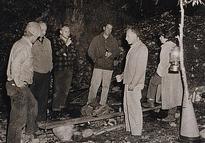
November 1959, first day of the Pacific Northwest Expedition, Bluff Creek, California: Pictured are the original personnel, from left to right, Ed Patrick, Tom Slick (co-sponsor), René Dahinden, Kirk Johnson, Jr. (co-sponsor), Bob Titmus, and Tom’s secretary, Gerri Walsh. Behind the camera, and also at the campsite as a member, was John Green.
One of the founding fathers in Bigfootry, Ed Patrick formally of Redding and Hoopa, California, passed away on June 19, 2009, I’ve just been informed by Daniel Perez, editor of the Bigfoot Times.
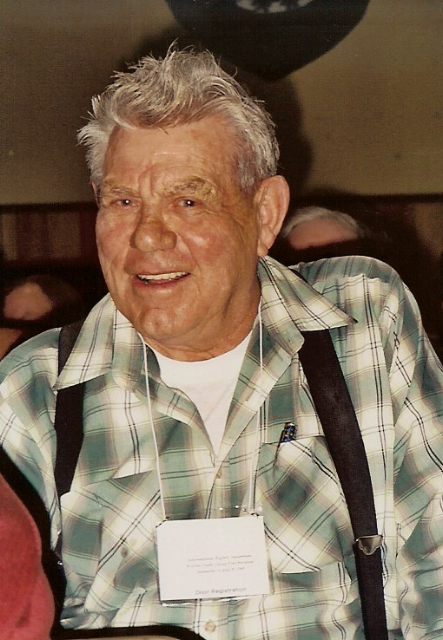
Edward Richard Patrick, September 2003, Willow Creek Bigfoot Symposium, California. Photo courtesy and copyright Daniel Perez.
A key but often forgotten figure in the early history and beginnings of Bigfoot/Sasuquatch investigations, Ed Patrick died in Wonewoc, Wisconsin at the age of 83, after a lengthy illness. Wonewoc, the location of Patrick’s relatives, is a village in Juneau County, Wisconsin, along the Baraboo River. Patrick, by coincidence, frequented Alaska, the state more associated with the name Juneau, where he loved to go hunting and had a stepdaughter and step grandchildren.
Patrick’s Bigfoot activities were not widely known to the public because he never sought a podium and was overshadowed by his more famous buddy of the time, Bob Titmus. But Patrick was there in the initial days and assisted in contributing to the collection of more solid evidence for the existence of the creature than had previously occurred.

Bob Titmus and Syl McCoy with Bigfoot casts. Photo by John Green.
Ed Patrick shared in a pivotal role in the first public debut of “Bigfoot” in California in October, 1958. At the time of sightings and finds of large footprints by a road crew of a large hairy hominid along Bluff Creek, Patrick’s friend, Bob Titmus, owner of a taxidermy shop in nearby Redding, became interested in the incidents. It would be Titmus who supplied another old friend, construction worker Jerry Crew with the plaster-of-Paris and the instructions for using it that enabled Crew to make his famous cast of one of the 16-inch prints being found on the newly built dirt road above Bluff Creek, in the northwest corner of the state.
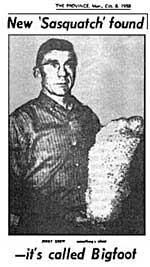
Jerry Crew (above and below, right) took his cast to the local newspaper, and editor Andrew Genzoli (below, left) published his now-famous illustrated story in the Humboldt Times on October 5, 1958. As Mark A. Hall observed: “The publication of that picture of him holding an enormous foot-shaped plaster cast was a turning point in the pursuit of wildmen in North America. Everybody wanted to see whatever was making such imprints.”
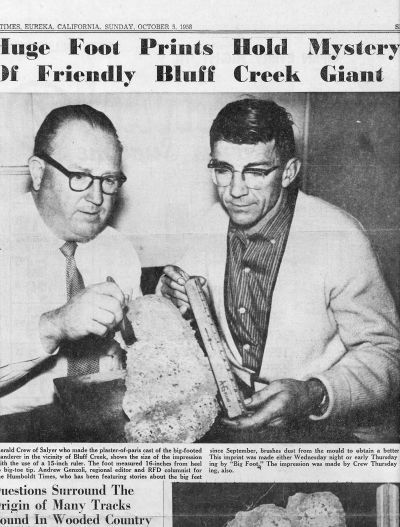
Photo courtesy, Bigfoot: The Life and Times of a Legend.
A few weeks later, on November 2, 1958, Bob Titmus and his hunting and tracking associate Ed Patrick overturned the notion that “Bigfoot” was, as John Green characterized it, “a freak individual, by finding and casting distinctly different 15-inch tracks on a sandbar beside Bluff Creek.”
Those tracks were not in soft dirt like those on the road, but in hard-packed wet sand, yet they averaged an inch in depth. The casts that Titmus and Patrick made then were followed up a year later with very similar ones being found on the same sandbar.
Due to the finding of those November 1959 Bluff Creek prints, Texas oil millionaire Tom Slick was drawn into the search, as I detail in my book on the man behind funding those beginning quests for Abominable Snowmen, Sasquatch and Bigfoot.
Ed Patrick became one of the most trustworthy and steady members of a small group of early Bigfooters involved in the Tom Slick-sponsored “Pacific Northwest Expedition,” formed in 1959. John Green would write years later that it would be Patrick that stayed out in the field the most, for others, such as René Dahinden grew disgusted with the personal infighting and went back to Canada, while Titmus had to go home to run his business.
The days of early Bigfoot hunting faded as personal conflicts were often more problematic than the elusiveness of the hairy hominid quest. People financially interested in backing the search also died too young.
Tom Slick, 42, died in a mysterious midair explosion on October 6, 1962. Fellow millionaire Kirk Johnson Sr., who co-funded the Yeti and Bigfoot expeditions, died in June 1963, and his adventurous son, Kirk Johnson Jr., who would search with Tom Slick in California, died in a strange hospital accident in 1968.
Then the hunters grew older and, in recent years, began dying.
Bob Titmus.
On July 1, 1997, Bob Titmus, 78, passed away near his home in British Columbia. His collection of Bigfoot research material, including his casts and notes, photos and other material collected was donated to the Willow Creek – China Flat Museum in California. Track casts that both Ed Patrick and Bob Titmus took can be found on display there today.

Sasquatch hunter René Dahinden, born in 1930, died on April 18, 2001.
Photo imagery courtesy of Sasquatch Odyssey: The Hunt for Bigfoot
Now the 83-year-old Ed Patrick is gone.
Born December 18, 1925, in Summit Township, Wisconsin, Edward Patrick served in the US Army in WWII in the 232nd Infantry in Germany. He has been laid to rest in Potter Cemetery in Juneau County, Wisconsin.
Even in his official funeral announcement, his family reported that one of Edward Patrick’s “greatest passions was [his] many years of searching for Bigfoot.”
His sister Norma Sonnenberg, whom he lived with during the last two years of his life, wrote Daniel Perez of the Bigfoot Times, informing Perez of the death. She said that one of her brother’s high points of his month was waiting for his copy of the Bigfoot newsletter. She also mentioned that she still has the plaster cast of a Bigfoot that he sent her many years ago.
Our condolences to the family and friends of Ed Patrick, another great one who has moved on to the Sasquatch happy hunting grounds.
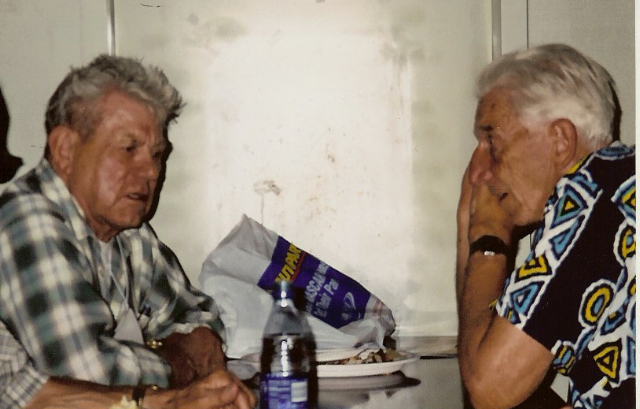
Ed Patrick and John Green, September 2003, Willow Creek, California. Photo courtesy and copyright Daniel Perez.
About Loren Coleman
Loren Coleman is one of the world’s leading cryptozoologists, some say “the” leading living cryptozoologist. Certainly, he is acknowledged as the current living American researcher and writer who has most popularized cryptozoology in the late 20th and early 21st centuries.
Starting his fieldwork and investigations in 1960, after traveling and trekking extensively in pursuit of cryptozoological mysteries, Coleman began writing to share his experiences in 1969. An honorary member of Ivan T. Sanderson’s Society for the Investigation of the Unexplained in the 1970s, Coleman has been bestowed with similar honorary memberships of the North Idaho College Cryptozoology Club in 1983, and in subsequent years, that of the British Columbia Scientific Cryptozoology Club, CryptoSafari International, and other international organizations. He was also a Life Member and Benefactor of the International Society of Cryptozoology (now-defunct).
Loren Coleman’s daily blog, as a member of the Cryptomundo Team, served as an ongoing avenue of communication for the ever-growing body of cryptozoo news from 2005 through 2013. He returned as an infrequent contributor beginning Halloween week of 2015.
Coleman is the founder in 2003, and current director of the International Cryptozoology Museum in Portland, Maine.











RIP and happy hunting for Ole Hairy in the Great Beyond, Mr. Patrick.
Godspeed.
Well maybe he knows the truth now. As for the rest of us we can only guess. Rest in Peace Ed. Your work here is through, but rest assured that where you have left off, you have inspired many others to pick up your quest. I think Walt Said it best.
“Around here, however, we don’t look backwards for very long. We keep moving forward, opening up new doors and doing new things… and curiosity keeps leading us down new paths.”
–Walt Disney